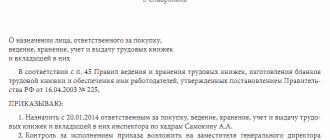Why is it necessary to record and store documents in an organization?
Any direction of the company’s work, any operation must be documented. This applies, inter alia, to the production, financial, accounting, economic and personnel activities of an enterprise, where the presence of specific supporting documents is enshrined at the legislative level.
Correctly executed documents containing all the necessary details certify established procedures, confirm their legality and allow the state to control the activities of business entities.
Accounting and storage of documents in an organization allows you to uniquely identify each document by assigning it a unique registration number, ensure its safety and prompt search. Minimizing the time and effort spent searching for documents significantly increases employee productivity and makes it possible to present the documents requested by regulatory authorities immediately, as requests are received.
Registration and storage procedures for documents in an organization must be regulated in accordance with their type and the nature of the company’s production activities, taking into account the features of its structure and organizational processes.
Procedure and terms of storage of documents of various types
The general provisions that must be followed when developing a local regulatory act establishing the procedure and terms for storing documents at an enterprise are set out in:
- Federal Law of October 22, 2004 No. 125-FZ “On Archival Affairs in the Russian Federation”;
- “Basic rules for the operation of organizational archives”, approved by the decision of the Federal Archives of 02/06/2002;
- A list of standard management archival documents generated in the course of the activities of state bodies, local governments and organizations, indicating storage periods, approved by Order of the Ministry of Culture of Russia dated August 25, 2010 No. 558, hereinafter referred to as List No. 58.
Please note: If an enterprise is organized in the form of a joint stock company, that is, its activities are related to securities, the procedure and terms for storing documents in the organization must comply with the special requirements established by the FCSM Resolution No. 03-33/ps “On approval of the Regulations on the procedure and terms documents of joint stock companies."
Procedure and terms of storage of statutory documents
Statutory documents are of paramount importance in the activities of the organization and are stored in a special way - in a separate folder, which is placed in a safe, access to which is available only to those officials whose list is approved by order of the head. Responsibility for the safety of title documents rests with the manager or chief accountant of the enterprise. Paper originals of statutory documents are now almost never used - after registering an enterprise in the Unified State Register of Legal Entities, all the necessary information is publicly available.
The storage period for statutory documents is unlimited, and in the event of liquidation of the company, they are transferred for archival storage to a specialized organization in the prescribed manner.
- Rules for registering documents
- How to determine storage periods for documents using different lists without errors
- We create documents and work with them in CRM systems
Procedure and terms of storage of accounting and tax documents
At the end of the calendar year, these documents are filed into files, the folders with which are stored in specially equipped cabinets in the accounting department for another 3-4 years, and then transferred for storage to the enterprise archive.
The procedure for storing accounting documents in an organization is established in accordance with the Regulations on Documents and Document Flow in Accounting, approved by Order of the USSR Ministry of Finance dated July 29, 1983 No. 105. At the same time, the difference in the storage periods of such documents is explained by differences in the degree of importance, the need for the calculation and payment of taxes, and accounting.
This is important to know: Job responsibilities of an excavator driver
Those primary documents in accordance with which taxes and insurance premiums are calculated and deducted, according to the Tax Code of the Russian Federation, must be stored at the enterprise for at least four years. Such documents include those that confirm the receipt of income, expenses incurred by the enterprise and payments to the budget for taxes. At the same time, according to the law on accounting, the procedure for storing accounting documents requires a five-year minimum storage period and compliance with the rules for organizing state archival affairs.
The table shows the deadlines established for storing different types of accounting and tax documents.
Analytical documents (tables, reports) for the annual financial statements
Personal cards, employee accounts
Transfer, separation, liquidation balance sheets, appendices, explanatory notes to them, certificates of registration
Workers' writs of execution
until the need passes
Forms of statistical reporting forms in organizations that are not their developers
Documents confirming the calculation and payment of insurance contributions to extra-budgetary funds
The procedure for storing personnel records documents
Work records of employees are stored in a safe, which ensures their safety in the event of a fire or flood. Other personnel records are stored in specially equipped cabinets that ensure the absence of unauthorized access to them in accordance with the legislation on personal data. The storage periods for personnel documents are established by Art. 22.1 of the Federal Law of October 22, 2004 No. 125-FZ, they are presented in the table:
Personnel documents
Created before 2003
Created after 2003
Formed in state, municipal bodies and organizations that are sources of acquisition of state archives
75 years from the date of creation
50 years from the date of creation
Formed in state and municipal archives, received from liquidated organizations of all forms of ownership
75 years from the date of admission
50 years from the date of admission
Formed in other organizations
75 years from the date of creation
50 years from the date of creation
Please note: the destruction of these documents is permitted on the basis of the relevant act, that is, only after an examination of their practical, scientific, historical and cultural value has been carried out. A sample act on the allocation of documents for destruction can be downloaded.
What document regulates the procedure for storing documents?
The enterprise must develop its own list of documents that are subject to mandatory storage. An order on the procedure for storing documents in an organization, an example is presented below.
In most cases, the procedure for storing documents in an organization is regulated by the archival legislation of the Russian Federation and List No. 558, but regulations developed at the state level cannot cover all the variety of documents that are generated in the course of enterprise activities. In such cases, industry and departmental lists can be used as regulations, for example:
A list of documents with storage periods generated in the activities of the Central Bank of the Russian Federation;
A list of documents generated in the activities of governing bodies, military units of civil defense forces, fire service units, institutions, organizations of the Ministry of Emergency Situations of the Russian Federation;
A list of documents generated in the activities of the Savings Bank of the Russian Federation and institutions of its system, indicating storage periods;
A list of documents generated in the activities of the Federal Tax Service, its territorial bodies and subordinate organizations, indicating storage periods.
These regulations can be used as reference books by companies whose activities are carried out in related areas.
Where should employee job descriptions be kept?
Job descriptions (hereinafter also referred to as DI) of employees must be stored at the place of development or approval (clause 77 of the order of the Ministry of Culture of Russia dated August 25, 2010 No. 558). They are usually stored at the location of the employing organization. The employer can determine the specific storage location independently, since the competent government agencies do not give special recommendations in this regard.
At the same time, DI can be transferred for storage to other organizations, for example:
- to the archives;
- companies providing document storage services, etc.
You can find both recommendations and templates for drawing up certain types of financial statements in other materials on our website, for example in the articles Job description of the chief accountant of an LLC (sample) 2020 or Job description of the general director of an LLC - sample 2017.
DI, which is an integral part of the employment contract, is stored along with it. DI approved as an independent document can be stored separately from the corresponding employment contracts.
At the same time, the requirements for ensuring the security of storing personal data of employees must be met (Article 87 of the Labor Code of the Russian Federation).
Registration of job descriptions according to GOST in 2019
Despite the fact that the law does not contain direct regulation for the creation of job descriptions, there are certain rules specifically for the creation of organizational and administrative documentation.
Thus, Resolution of the State Standard of the Russian Federation dated 03.03.2003 N 65-st approved GOST, used in the creation of unified forms of personnel documentation, to which the instructions, by the way, apply.
Also, when developing a DI for each position, the ETKS norms are taken as a basis, which contain both the requirements for a particular position and a standard list of responsibilities.
Primary requirements
It should be noted that from the date of signing by the parties, the instructions will be a local document, the norms of which both the employer and the employee must comply with.
That is why mistakes cannot be made when developing this document, otherwise, under Article 8 of the Labor Code of the Russian Federation, the instruction may be declared invalid, which in turn will entail other difficulties.
That is, the DI must initially be created both taking into account GOST and the recommendations of the ETKS, and also contain certain attributes inherent in local documentation, which includes not only the signatures of the parties and mandatory approval, but also standard sections in compliance with a certain structure.
Order and rules
Of course, a job description is a local act in which labor law norms are closely used, which predetermines the extension of the requirements of Article 8 of the Labor Code of the Russian Federation to the specified document.
That is, one of the basic rules when creating a labor regulation is full compliance with the rights granted to employees within the framework of labor relations, taking into account that a contradiction in the form of a violation of the same labor function can lead to the cancellation of the instruction.
At the same time, no less important is the procedure for creating the specified document, which has legal force and makes it possible to use the instructions not only as a tool for regulating the labor process, but also as a compelling argument in controversial situations.
That is, the DI at a minimum must be developed taking into account the above documents and be approved within the framework of the rules stipulated by Resolution No. 65-Art.
Questions and answers on the topic
- How to correctly indicate the acting head of the department in the documents?
- In which organizations should the position of scientific secretary be established?
- How to formalize the extension of a driver’s job function?
- How can I change the department name and job responsibilities?
- How is a company car registered?
Why are employee job descriptions needed?
A job description is an internal document that defines the job responsibilities of an individual employee in a position held in a specific organization, as well as establishing his powers and responsibilities.
Although the responsibility for drawing up job descriptions rests only with government agencies, private organizations can also greatly benefit from this document. A job description, provided it is drawn up correctly, allows you to solve a number of problems:
- rationally distribute the functional responsibilities of employees, determine the connections between them;
- specify the rights and responsibilities of employees;
- increase personal and collective responsibility of staff;
- provide the necessary information for the selection of candidates for employment;
- familiarize the employee with the list and scope of actions expected from him, with the criteria for assessing his work, with priority areas for improving the level of qualifications, etc.;
- conduct an assessment of the employee’s work and decide on ways to develop his career in the organization;
- serve as an evidence base in labor disputes;
- terminate the employment contract due to the employee’s inadequacy for the position held.
This is important to know: Job descriptions (job responsibilities) of a ward nurse and a pharmacy nurse
Order on approval of job descriptions
The approval order is not a mandatory document, but its use must be carried out in the absence of other approving points. For this purpose, it is necessary to introduce a provision into the local acts of the enterprise on the use of the order as an approving element.
Who develops job descriptions in an organization?
Important
What should you do if the chief accountant asks you to write job descriptions for employees? You must say: “I will show you the form and methodology for developing this document. And then write yourself. I don’t know your professional subtleties, this is not my function.”
Attention
That is, you must explain in detail the form of this document, general provisions, all points and sub-points that are necessarily included in the job description. This is your responsibility. Because you are the only specialist in your organization who knows what a job description is and what follows from it.
You know that if an employee does not follow instructions, he can be fired. You can dismiss under Article 33, paragraph 2 - the employee’s inadequacy for the position held. According to Article 33, paragraph 3 - systematic failure to fulfill official duties. These subtleties are within your control.
Recording and storage of employee job descriptions
Typically, the responsibility for drawing up job descriptions for subordinate employees is assigned to the heads of departments, and the organization’s personnel service maintains records and storage of job descriptions for employees.
Read more about job descriptions here:
- How to update job descriptions taking into account professional standards
- Is the organization required to draw up job descriptions?
- Can an employer independently obtain a certificate of no criminal record for an employee?
Heads of structural units can determine the subordination of personnel in the unit in the most rational way, distribute functional responsibilities among subordinate employees and resolve other issues related to the assignment of job responsibilities. The drawn up instructions must be agreed upon with personnel and legal department employees, and, if necessary, with other interested parties of the organization. After approval, the job description is signed by the compiler and approved by the head of the organization.
The job description is impersonal, that is, it is developed not for a specific employee, but for a specific position included in the staffing table. Most often, a job description is put into effect for a vacant position, that is, before searching for and hiring a suitable employee for this position.
A convenient option for storing job descriptions is centralized storage in the personnel service, which introduces them to hired employees. However, many enterprises prefer to store job descriptions in structural divisions or in the office.
Who in the enterprise should develop job descriptions?
In practice, the validity period ends when the manager decides on the need to revise the document.
In turn, the frequency and timing of revision are established by the regulations on the development of such instructions. Some companies specify deadlines for when such work must be completed. This could be once a year or once every three years. In practice, this approach is rarely used. Most often, the order for the development of instructions indicates the circumstances when a review must be made. The reason may be a change in the name of the company, working conditions, staffing levels or other features of the enterprise.
Retention periods for employee job descriptions
Sometimes after the job description has been drawn up and approved, additional questions arise. What to do next with this document? Where should it be stored? What is the shelf life of job descriptions?
The fundamental issues of storage, use and recording of documents are answered by the Federal Law of October 22, 2004 No. 125-FZ “On Archiving in the Russian Federation.” More detailed issues are regulated by other regulatory legal acts. For example, to determine the storage periods for various documents, one should rely on regulations that establish storage periods for standard management documents.
Today, to determine the storage period for a certain type of document, you can rely on the List of standard management archival documents generated in the process of activities of state bodies, local governments and organizations, indicating storage periods, approved by Order of the Ministry of Culture of Russia dated August 25, 2010 No. 558.
According to this list, standard job descriptions, as well as other provisions on the rights and responsibilities of officials, must be kept permanently at the place of development or approval. If a standard job description is developed and approved by another organization, then the shelf life of the old instructions at the place of use is 3 years after replacing it with a new one.
As for individual job descriptions of employees, their shelf life is 75 years.
How to prescribe in the regulations the procedure for storing job descriptions - Legal assistance from a lawyer
As for the standard (approximate) job description, it, according to the Order, is subject to permanent storage in the organization that developed it, and its certified copies in other organizations (if such is provided for by the organization’s clerical work) have a short shelf life - it is 3 years, after that How will inactive editions of job descriptions be replaced with new ones?
Individual job descriptions of personnel are placed in personal folders (personal files) of employees and must be stored for 75 years. Important
The “Job Description Requirements” section should list the names of the sections and what should be reflected in them. Typically, a job description consists of four sections:
- General provisions;
- Job responsibilities;
- Rights;
- Responsibility.
But, since the law does not stipulate the specific requirements of this document, its text can be supplemented, for example, with the following sections:
- Relationships and connections by position;
- Work evaluation criteria.
The Regulations should indicate that the employee’s obligation to comply with the requirements of the job description arises only after obtaining written consent or in the form of signing an additional agreement to the employment contract.
Attention
Surprisingly large reference database on personnel records management Forum of personnel officers. Personnel records management » Personnel records management We welcome you to the forum of HR professionals and newcomers to personnel affairs, dear colleagues! There are already more than 250,000 messages on our forum, more than 26,000 topics, and most importantly, we always have an excellent team and a spirit of mutual assistance.
Newbie guests please USE THE FORUM SEARCH! Most questions have already been answered. Please be mutually polite. Our forum is for pleasant professional communication, cooperation and mutual assistance.
General recommendations for developing job descriptions
Organization of notarial business" (volume 1) (3rd edition, revised and expanded) (edited by I.G. Medvedev) ("Statute", 2015) Job descriptions for notary office employees.
The case is included in the Approximate Nomenclature as an independent one with the index 01-07, the established shelf life is three years after replacement with new ones.
Job descriptions of employees determine the scope of job responsibilities performed by the employee in accordance with his position. The matter is moving. Article: Personnel documents: destruction according to the rules (Suverneva A.I.
)("Human Resources Department of a Commercial Organization", 2020, N 4) We believe that the work of maintaining an organization's archive is within the capabilities of any employee (you can formalize this as a combination, or you can introduce this responsibility into the job description, for example, of a secretary).
Shelf life of job descriptions
And finally, the seal is affixed. 1.3. Making changes to job descriptions.
To prevent job descriptions from becoming useless papers, they must be dynamic, promptly reflecting structural, organizational, production and other changes.
Therefore, special attention should be paid to their timely updating. This approach makes job descriptions relevant documents, the content of which corresponds to the conditions, tasks and needs of management.
job descriptions
In the “Final Provisions” section, the procedure and terms for the entry into force of job descriptions should be established, and the procedure for storing originals should be determined. Job description: details and order for entry into force Since the job description is a local regulatory act, it must have all the formal characteristics of an official document.
Therefore, when developing a document such as the Regulations on Job Descriptions, special attention should be paid to how to correctly draw up and what details they should contain that make them a normative act. All necessary information must be placed on the title page that opens the job description.
Job descriptions. storage rules
The section indicates: job title; requirements for the education and work experience of the official filling this position (qualification requirements); direct subordination (to whom the official is directly subordinate); procedure for appointment and dismissal; presence and composition of subordinates; replacement procedure (who replaces this official during his absence; who replaces this official); the possibility of combining positions and functions; the regulatory framework of his activities (fundamental regulatory and organizational-legal documents on the basis of which the official carries out official (labor) activities and exercises his powers). The section may include other requirements and provisions that specify and clarify the status of the official and the conditions of his activities. · Job responsibilities.
https://youtu.be/VZpgEoCVjCs
Approval stamp - when a document is approved by an official, the document approval stamp must consist of the word APPROVED (without quotation marks), the title of the position of the person approving the document, his signature, initials, surname and date of approval. Signature of the document developer - this detail includes: the name of the position of the person who signed the document; personal signature; decryption of signature (initials, surname).
Approval stamp - the document approval stamp consists of the word AGREED, the position of the person with whom the document was approved (including the name of the organization), personal signature, transcript of the signature (initials, surname) and the date of approval. Mark on the employee’s familiarization with the document - after the instruction comes into force, it is necessary to familiarize the employee with it and put a mark on familiarization.
How to prescribe in the regulations the procedure for storing job descriptions
Source: https://dipna5.ru/kak-propisat-v-polozhenii-poryadok-hraneniya-dolzhnostnyh-instruktsij/
The legislative framework
The storage period for job descriptions is regulated by legislative acts:
- Order of the Ministry of Culture of Russia No. 558 of 2010 approves the list of personnel documents to be stored, and on the basis of this act the safety of job descriptions is carried out.
- In addition, paragraph 77 of this legislative act indicates the storage location of the paper establishing the state’s operating rules with full security of employee identification data in accordance with Art. 87 Labor Code of the Russian Federation.
- In addition, there is a list No. 41, and since 2013, a list No. 578/5 for the period of preservation of documentation.
- The obligation of organizations to preserve documents related to the supervision of personnel work is enshrined in Art. 17 Federal Law No. 125 of 2004 on archival matters.
- Part 3 art. 6 of the same law indicates the mandatory approval of the list of personnel documents indicating the deadlines for each of them by the relevant responsible structures.
- The storage period for job descriptions in the new edition of Order of the Ministry of Culture of Russia No. 558 is indicated in section 1.2.
It should be understood that the requirements specified in these legislative acts are effective for all companies, without exception, operating in Russia - if the organization is of foreign origin, then its requirements and needs should be taken into account, but with reference to the legislative acts of the Russian Federation created for accounting regulations and storage of documents.
What laws govern the handling of job descriptions?
All enterprises operating on the territory of the Russian Federation must comply with uniform legal standards. All HR specialists should study the following legislation:
- Order of the Ministry of Culture of Russia No. 558 of 2010 contains a list of documentation that enterprise owners are required to store for a certain time. Pay attention to paragraph 77, which specifies where exactly the papers should be stored. The new version of this law contains section 1.2 - it must be followed when determining storage periods.
- Article 87 of the Labor Code of the Russian Federation regulates the safety of employee identification data. It indicates in which acts the employer has the right to indicate last names and other personal information.
- The retention period for documentation can be found in List No. 41 and List No. 578/5. The latest document is more modern, it came into force in 2013.
- The Federal Law “On Archiving”, issued No. 125 of 2004, indicates the obligation of organizations to store documentation related to the regulation of personnel work. Part 3 of Article 6 states that HR specialists are required to draw up a list of documentation that should be stored. It must indicate exact deadlines.
- Letter of Rostrud No. 4412-6 of 2004 and Article 8 of the Labor Code of the Russian Federation indicate the responsibilities of the employer that must be observed during the creation of these local acts.
Foreign companies also operate in accordance with the legislative acts of the Russian Federation.
How many copies should there be?
Before determining the number of copies of the job description to be generated, it is necessary to go through certain steps to create it:
- Existing positions in the enterprise are highlighted, since for each of them, according to the characteristics of the functions performed, its own document is drawn up.
- Conclusion of the procedure on the development of job descriptions in a separate Regulation.
- Making a decision on its creation, for example, by a separate order of the manager.
- A group of specialists is formed to develop it, usually not including lawyers, shop foremen, and accountants.
- The structure and content of the briefing is determined.
- The form is agreed upon, finalized, and determined.
- Signed, approved and registered.
- Familiarization of employees with what they have read against signature - an autograph can be placed on a document or on a special familiarization sheet.
For some employees, it is not necessary to create a job description at all; it is enough to indicate all the points regarding job duties, rights and responsibilities in the employment contract.
At the same time, the legislation, in contrast to the standardization of the number of copies of the employment agreement, does not put forward any special requirements for instructing documentation in this regard.
In most cases, there is only one original document, but such instructions are a kind of manual in connection with which employees are given an approved and endorsed copy of it in order to find it at the workplace.
However, there are enterprises where the importance of the job description is enormous, as a result of which three copies are created - for the employee, the HR department and archiving.
When is it necessary to publish a new edition of a document?
A document developed once at an enterprise can be valid for years. Replacing it is necessary only in the following cases:
- changing the name of the organization;
- change of leadership;
- the position was taken by another employee or the previous one changed his last name;
- the enterprise has been reorganized;
- there is a need to add new items to the document (for example, after installing new equipment or due to an expansion of the employee’s responsibilities);
- The job title has changed.
If it is necessary to replace the current job description, an order from the manager is issued, and then the document is developed in the usual manner. Local acts that have lost force must not be destroyed for 5 years (since 2013).
The law does not impose any special requirements for the storage location of instructions. In most cases, it is advisable to store them at the place of development, that is, in an organization acting as an employer. But it is acceptable to pass them:
- to the archives;
- companies involved in document storage.
The storage location of the instruction must be indicated in the Regulations on its creation (if it is published). Registration of a job document is optional. In this case, maintaining documentation of employees is completely left to the discretion of the employer.
Mandatory periods eventually replaced by a new edition
The legislation defines two types of instructions to clarify the storage of each of them:
Standard and unified documents developed, for example, by industry structures are subject to permanent storage;
For 75 years, individual job descriptions of scientists and those working in harmful/dangerous and difficult conditions, as well as those equivalent to them, will be preserved;
All others must be stored at the enterprise until its cessation of existence.
Sometimes a job description needs to be updated, but it is worth understanding that the document regulating rights and obligations can work for years; it is not advisable to replace it annually.
Replacement may be necessary if:
- the name of the organization has changed;
- management has changed;
- reorganization took place;
- the surname of the employee to whom the existing type of document relates has been replaced;
- when changes are made to the document itself, for example, in connection with the installation of new equipment;
- when the job title changes.
This is important to know: Assistant Manager: responsibilities and requirements
The document is replaced with a new version by order of the manager.
In the case of replacing an outdated job description template with a new edition, it was previously stored for an additional 3 years, counted from the date of replacement, but since 2013, after some changes in the rules for storing and destroying documents, up to 5 years.
That is, an old document that has received an update should be stored for another 5 years from the date of publication of the new sample, the new one, in turn, should be stored in accordance with generally accepted requirements, taking into account its type - 75 years or on an ongoing basis.
If a document is formed as a mandatory attachment to an employment contract, it is stored together with the main document on cooperation for 75 years, this is stated in paragraph 657 of Order No. 558.
Specialists responsible for storage and violating established requirements are held accountable in accordance with Art. 13.20 of the Code of the Russian Federation on Administrative Offences.
Thus, the job description:
- It does not fall under the strict regulation of the law, both at the time of its creation and the formation of the number of copies, and regarding the rules for its storage.
- But at the same time, the main points are highlighted regarding the storage methods that the employer has the right to choose.
- Regarding the storage period, taking into account its type or method of formation - a separate document or as an annex to the contract.
Instruction sections
The instructions are divided into different sections. Let's consider their features.
General provisions
This section provides basic information:
- Employee's position.
- Division name.
- Subordination of the employee.
- The procedure for appointment and removal from a position.
- Features of replacing a main employee with a temporary one.
- Requirements for training and knowledge: education, experience.
It is also necessary to indicate a list of regulations on the basis of which the employee works (TC, internal regulations, orders, etc.).
The general shelf life of job descriptions and the shelf life of job descriptions after replacing a new one
In order to regulate the storage periods of DI, there are 2 types of such documents:
- standard and unified DI, developed, for example, by industry departments, are subject to permanent storage;
- Individual DIs are stored for 75 years.
In this case, an outdated DI replaced by a new edition must be stored for another 3 years from the date of its replacement. Thus, an MDI that has lost its relevance can be disposed of 3 years after its replacement. The rules for storage for 75 years or permanent storage apply to the newly introduced MDIs - for individual and standard MDIs, respectively.
We also note that the DI, which is part of the employment contract, must be stored together with it for 75 years (clause 657 of order No. 558), the DI - an independent document must be stored for 75 years, since it is individual.
Officials who violate the established rules for storing personnel documentation may be held accountable under Art. 13.20 of the Code of the Russian Federation on Administrative Offences.
So, job descriptions can be stored both at the place where they were developed and approved, and in other organizations. In this case, standard DIs must be stored on an ongoing basis, individual DIs - for 75 years, and DIs that have been replaced by their current versions - for 3 years from the date of replacement.
Correct design
A job description (hereinafter referred to as DI) is the main organizational and legal document of a legal entity, which is drawn up for each full-time position.
It clearly states the duties and responsibilities of company employees when carrying out their work activities in a specific position.
DI consists of the following sections:
- "General provisions". Here they indicate the name of the position and information about it, the procedure for appointment and dismissal, professional and qualification requirements, a list of documents regulating job responsibilities.
- "Main tasks and functions." This section specifies a list of tasks that the employee must perform.
- "Responsibilities". Here are the requirements that employees must adhere to while performing their job functions.
- "Rights". The section describes the range of rights necessary for operating personnel to implement their assigned responsibilities.
- "Responsibility". The section contains a list of forms of employee responsibility for the results and consequences of the activities performed.
- "Interconnections". Here you should specify the procedure for the official’s interaction with other employees and departments.
Who should be entrusted with drawing up job descriptions? The head of any organization is primarily interested in the correct execution of DI, so he must decide for himself who will do this.
The development of documents can be entrusted to employees of the HR department or the head of the HR department. If you have the appropriate knowledge, the employer can independently draw up job descriptions.
How long is the document valid?
The instructions should contain the following sections:
- General provisions - company name, subordination, qualification requirements, list of regulations that the employee must follow when fulfilling his obligations.
- Goals and responsibilities. This section reflects organizational responsibilities and functional tasks.
- Rights and powers. When preparing this section, it is important to clearly describe what responsibility management and subordinates bear when summing up the results of the enterprise. It is important to indicate the possibility of making decisions, the presence of the right to sign documents, and so on.
- Subordination, leadership. Here you need to indicate who the immediate supervisor is. If an employee must submit any reports based on performance results, this point must also be reflected in the instructions.
- Interaction with other services. Here we consider actions that an employee can carry out independently in the sphere of interaction with other services without warning from management.
- Responsibility. The most important section deals with the employee's liability in case of failure to fulfill obligations. A group of different offenses may also be listed here.
One of the key points is the validity period of the job description at the enterprise. This period is not specified or limited by law.
Normative base
Labor legislation does not directly oblige organizations to develop DI. It is assumed that the employer will be able to describe the job rights and responsibilities of employees in the text of the employment contract.
But if the enterprise does not develop DI or the working staff is not familiar with them upon signature, it will be extremely difficult for the employer to ask work from free-will employees. After all, he will have no legal grounds for this.
In Art. 29 of the Labor Code of the Russian Federation states that the employer is obliged to familiarize the hired employee with his rights and responsibilities, as well as inform him about working conditions, the presence of harmful and hazardous production factors. This must be done against a signature.
The main legislative document is Resolution of the Ministry of Labor of the Russian Federation No. 37. The regulatory act contains a list of qualification characteristics of positions for all sectors of the economy. Employers can use them as a basis for creating DI.
When developing documents, you can be guided by the following regulations:
- Labor Code of the Russian Federation;
- OKPDTR (dated December 26, 1994 No. 367);
- ETKS for various sectors of the economy.
Development for a large company
The development of DI in large companies is usually carried out by HR managers. If the organization has no more than 20 positions, the manager's task is to conduct an analysis and create a job description, and then create a CI based on the information received.
But what if the company has more than 100 positions? In such cases, the responsibility to draw up regulatory documents falls on the heads of structural units. They take into account the role of each employee as one of the key resources of the organization.
A DI development project in a large company is implemented in several stages:
- determination of tasks, deadlines for their implementation, responsible officials;
- coordination of the project implementation plan with the top management of the company;
- preparing a questionnaire to collect information;
- motivating line managers to develop DI;
- tracking deadlines for filling out questionnaires in departments;
- analysis of the information received, preparation of DI sets for departments, making adjustments;
- approval of job descriptions by order of the company, implementation.
Compilation according to professional standards
Instructions drawn up in accordance with professional standards are in great demand in organizations today. When developing them, the provisions of the current professional standards for specific positions should be taken into account.
The clear form of the document is not regulated by law; the employer has the right to independently approve it. Job descriptions have a clear and concise structure; they reflect the main functions that are assigned to the employee.
- brief information about the organization;
- chain of command;
- general information about the position held;
- description of the work performed;
- rights and job responsibilities of working personnel;
- information about possible replacement;
- performance evaluation criteria;
- working conditions;
- a list of grounds for termination of business relations;
- personal qualities of the employee.
The role of job descriptions in organizations cannot be underestimated. It is this document that is the regulatory basis for applying enforcement measures to workers.
The unified form of the document is not approved by law. When compiling the DI, you can use the Decree of the Ministry of Labor of the Russian Federation of August 21, 1998 No. 37 and other regulations.
Information on how to effectively develop job descriptions is provided below.








